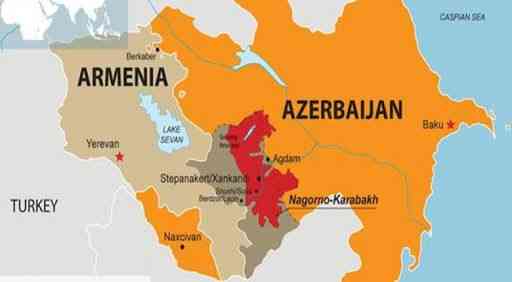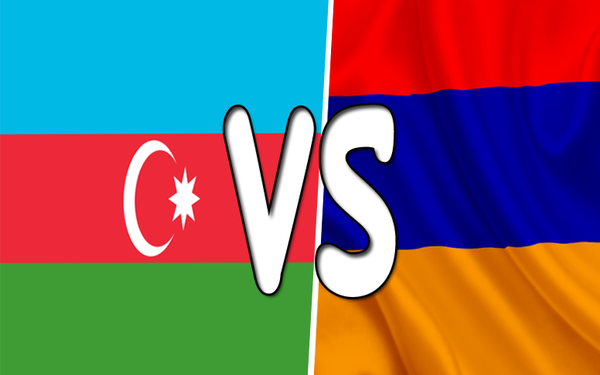The world media announced that Azerbaijan declared war on Armenia this morning, after confirming that the military and civilians were killed as a result of the military escalation that took place today, on 9/28/2020 in the disputed Nagorno Karabakh region, while the Armenian separatists declared a state of war and general mobilization. ..

Was this declaration of war emerging from this moment, or does history have another opinion?
Armenia[3]
A former republic of the Soviet Union, located in the Caucasus, bordered by Turkey to the west, Georgia to the north, and Azerbaijan to the east, while to the south it is bordered by Iran and the enclave of Nakhichevan of Azerbaijan.
Azerbaijan[3]
One of the six independent Turkish states in the Caucasus. It is located between Eastern Europe and Western Asia, bordered by the Caspian Sea to the east, Russia to the north, Georgia to the northwest, Armenia to the west, and Iran to the south, its official language is the Azeri language and its capital is Baku.
Causes of historical enmity
In fact, there are many reasons for war, there are ethnic reasons between Armenians and Azerbaijanis, there are political reasons, and there are religious reasons, as we know, Azerbaijan is a country with a Muslim majority while Armenia is a Christian country , but the main reason for the disagreement remains the dispute over the heights of Karabakh.
Karabakh Heights
With the nature of the region's location between Iran, Russia and Turkey, it was shifting between the sovereignty of states belonging to Turkey at times and states belonging to Russia at other times, for example in the year 1805 was part of Tsarist Russia, and it witnessed battles during the civil war that followed the Bolshevik revolution in 1917.
During Soviet rule, the Nagorno Karabakh region was annexed to the Azerbaijan Soviet Republic, as it is considered today part of Azerbaijan.
As we said earlier, the main reason for the war is the difference in the heights of Karabakh, and this dispute goes back to before the end of the First World War, that is, before the period of the complete collapse of the Ottoman Caliphate and the collapse of the Russian Empire, as Armenia, Georgia and Azerbaijan established an alliance called the Transocean Union. It did not last for more than three months, followed by the outbreak of war on three fronts: Karabakh, Naxchivan, and what is known as the Armenian province of Sion at the present time ...
The reason behind the outbreak of the war was the difference between Armenia and Azerbaijan on the imaginary borders of the three countries, and it is known that Karabakh is inhabited by many Armenians, but they are under Azerbaijani sovereignty. An Armenian known as Andranik Ozanian, his military entry was crowned with success until he reached the heart of the region, to the capital Shusha in particular, and this was in 1918.
Then Britain entered the region and appointed Azerbaijani statesman Khorsov Bey Sultanov as the ruler of the region and refused to grant ownership of the land except through a conference to be determined later.
Historical events[1]
In 1991, the Karabakh region declared its independence, but it did not gain the recognition of any state or the recognition of Armenia itself, and before the declaration of its independence three years until 1994, the region witnessed many armed conflicts between Armenians and Azerbaijan, which killed about 30 thousand people, most of them from Azerbaijan. Hundreds of thousands of people, most of them also, have been displaced.
At the beginning of December, after the fall of the Soviet Union and the independence of Azerbaijan on August 30, 1991, the people of the region voted for independence from Azerbaijan and the results of the vote indicated their desire to do so.
In 1993, as a result of the war that occurred in the year 1988, the Armenian forces gained control of a safe area located between Karabakh and Armenia, covering an area of 8 thousand square kilometers, or about twenty percent of the area of Azerbaijan. Then, in 1994, after the victory of the Armenian side, a ceasefire was declared, but without A peace agreement was concluded, which meant the continuation of the war in one way or another.
The Minsk group of the Organization for Security and Cooperation in Europe (Russia, the United States and France) tried to establish the situation between the two countries through negotiations, but it did not succeed in that.
In the year 2008 there were also the usual armed conflicts between the two parties, then in November Armenia and Azerbaijan signed a declaration calling for a peaceful settlement of the conflict, but the battles continued.
In 2012, Baho Sahakian (the fourth president of the unrecognized republic) was re-elected president of the Pagh Village for five new years, and he continued until May of 2020.
In August 2014, the Armenians killed many Azeri soldiers, and in the same year the Azerbaijani forces shot down an Armenian army helicopter, killing its three crew members. The Azerbaijani Defense Ministry announced later that this helicopter had attempted to attack the Azerbaijani army sites.
April 2016, due to clashes between the two sides, 18 people were killed among the Armenian forces and 12 with the Azerbaijani forces, according to what the two parties, who exchanged accusations, were responsible for the tension.
What happened yesterday between Armenia and Azerbaijan?[2]
A violent round of war erupted, with many deaths and injuries, followed by the Armenian separatists' declaration of a state of war and the mobilization of all able-bodied males over the age of 18 in the region amid calls to stop the fighting, and then the Azerbaijani Ministry of Defense announced to Agence France-Presse that it had liberated six villages It is under Armenian control within hours of the start of the conflict.
Falling dead and wounded[4]
As a result of the Azerbaijani bombing, at least 10 Armenian soldiers from the regional forces were killed, and a woman and her child were killed, according to what the Armenian forces declared, as well as the destruction of some facilities.
Who started the war?
Azerbaijan accused the Armenian forces of carrying out provocative actions on the morning of September 27, by firing light and heavy weapons at Azerbaijani military and civilian sites. This resulted in loss of lives and facilities.
The Azeri response was the bombing of the entire Armenian front line with the aim of protecting civilians and responding to what it described as Armenian provocations. It also said that it destroyed some Armenian military facilities and vehicles, including twelve OSA anti-aircraft missile systems.
It also said that the Armenian forces succeeded in destroying a helicopter belonging to the Azeri army, but its crew managed to escape.
While the Armenian side contradicted the version of the helicopter, it confirmed that it had shot down two Azeri military helicopters and three drones, and that was in response to the exposure of its facilities in the Karabakh region to military and air strikes, and the Azerbaijani forces were also accused of bombing their facilities and the capital of the region.
Finally, the reasons for which the war takes place periodically differ between the two countries, and whatever the reasons, man and nature remain the only losers in a war that knows no mercy...
Sources :
[1]
http://mubasher.aljazeera.net/news/بعد-إعلان-حرب-متبادل-تعرف-على-تاريخ-النزاع-بين-أذربيجان-وأرمينيا
[2]
https://www.bbc.com/arabic/world-54311094
[3]
https://www.britannica.com/place/Caucasus
[4]
https://www.aljazeera.net/news/2020/9/27/نزاع-قره-باغ-أرمينيا-وأذربيجان-يعلنان


